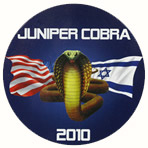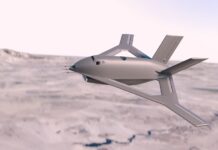Tel Aviv – 22 October 2009: Israel and the United States have launched today, Wednesday October 21, their first day of the three-week Juniper Cobra 10 air defense exercise, being the largest ever joint-military exercises in missile defense, to be held by the two nations. About a thousand U.S. troops, from all four branches of service, will work alongside an equal number of Israel Defense Force personnel, taking part in computer-simulated war games intended to ensure the two countries can jointly respond to a crisis. The two countries have held five such exercises since 2001. The Joint Task Force commander is Rear Admiral John M. Richardson, deputy commander of the U.S. Sixth Fleet. The exercise began October 21st and will last through November 3rd, 2009.

17 Sixth Fleet warships, including AEGIS destroyers armed with Standard SM2 missiles and support vessels are participating in the drills, along with 1,000 personnel from the U.S. European Command and about the same number of Israeli military personnel. The Juniper Cobra biannual exercises began in 2001, as the missile defense cooperation between Israel and the U.S. expanded. U.S. Patriot air defense batteries were deployed to Israel for the first time in 1991, to help defend the country from Iraqi missile attacks. These exercises are improving the interoperability and coordination between the two forces and establish close working relations between Israeli and U.S. personnel involved with missile defense.

As Exercise Juniper Cobra unfolds, it is expected to deal with an escalating scenario, challenging the bilateral, integrated missile defense systems with multiple types of simultaneous threats fired from different ranges. These could include coordinated missile barrages launched from Iran and Syria, along with continuous attacks by medium and short range rockets fired by Hezbollah from Lebanon and Hamas from Gaza. Such air defense missions will be performed simultaneously with extensive air operations, characteristic of wartime activity. According to Brig. General Doron Gavish, commander of Israel’s air defense forces, the exercise will focus on active defense (missile interceptors) and will not address other aspects of Israel’s defense posture, such as pre-emptive – offensive or passive defense. During the first phase unfolding this week, the forces will practice field deployments of air defense units. The second week will focus on command-post exercises, as deployed units and command posts on land and at sea will deal with simulated threats . The third and phase will involve live firing of Israeli Patriot missiles.
Among the systems expected to be deployed and tested during the drills are the Arrow-2 System Improvement Program (ASIP), and its associated Advanced Green Pine radar, the U.S. TPY-2 radar already positioned and operating in southern Israel, Israel Air Force Patriot and Hawk missiles systems; Patriot PAC-3 missile-interceptors deployed by U.S. forces from their European based, elements of the new Theater High Altitude Area Defense (THAAD) missile defense system and the naval-deployed AEGIS missile defense systems.
The U.S. forces are conducting regular exercises with international allied nations. Such exercises are planned more than a year in advance and require extensive coordination and preparation. However, joint exercises could also be used to mask strategic movements of forces. Just recently, the U.S. Central Command concluded the bi-annual Bright Star exercise in Egypt, rehearsing a massive parachute airdrop and equipment delivery. A similar exercise in 1990 preceded the coalition liberation of Kuwait, in response to the Iraqi invasion. According to some speculations, the U.S. could leave behind some of its advanced air defense systems deployed for the Juniper Cobra exercise. Such systems could include infrastructure equipment of even complete Patriot PAC-3 systems or elements of the THAAD, to be stored in the U.S. Army prepositioned equipment storages in Israel. However RADM Richardson stated that all U.S. units will be redeployed after the exercise.
In April this year, about 100 Europe-based personnel took part in a missile defense exercise that for the first time incorporated the U.S. owned X-Band TPY-2 radar system, which was deployed to Israel’ AIr Force base at Nevatim in the Negev desert in October 2008. This radar is intended to give Israel early warning in the event of a missile launch from Iran. For the past year, a small unit of U.S. troops and Defense Department contractors have been managing the radar station’s operations on site.












